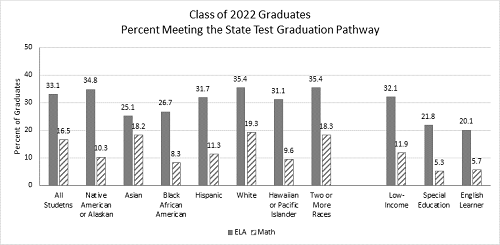Release Date:
In 2021, the legislature authorized the State Board of Education to establish an emergency waiver program to allow school districts to waive certain high school graduation requirements in the wake of COVID-19. The waiver was designed to be used on an individual student basis after the district makes a good faith effort to help the student meet the requirements. The Office of the Superintendent of Public Instruction (OSPI) has shared data on the total number of emergency waivers requested and issued, by school districts, including an indication of what requirement or requirements were waived for high school graduates.

The Class of 2022 consisted of 85,240 students, of which, 70,121 students were identified as graduates. Per the data, 174 school districts waived one or more course and/or pathway requirements for an unduplicated total of 9,049 impacted graduates in the final adjusted graduation cohort.
School districts and local educational agencies reported that approximately 9,200 courses were waived for 5,029 students (7.2 percent of the graduates) through the Graduation Requirement Emergency Waiver (GREW).
Social Sciences/History and English language arts (ELA) courses or credits were the most commonly waived. Art, Physical Education (PE)/Health, and World Language courses or credits requirements were less frequently waived for students. School districts and local educational agencies reported that 5,730 students (8.2 percent of the graduates) were granted a waiver of the graduation pathway requirement. Data show that Native American or Alaskan, Black African American, Hispanic, or Hawaiian or Pacific Islander students were more likely to be granted a credit/course and/or pathway waiver to meet graduation requirements as compared to students identifying with another race or ethnicity.
Takeaways
The full research brief is from the final data files provided by OSPI and reflects information only for students identified as high school graduates.
- 252 school districts applied and were approved to grant waivers for certain graduation requirements for the graduation class of 2022, which consisted of 85,240 students. However, only 174 school districts actually granted GREW waivers.
- Per the school districts reporting to OSPI, 9,049 students (12.9 percent of the 2022 graduates) were granted a credit waiver and/or a graduation pathway waiver.
- A total of 9,213 total courses were waived for 5,029 students, 7.2 percent of the graduates. English language arts (ELA) and Social Sciences/History courses/credits were the most commonly waived courses (45.1 percent of all credit and courses waived).
- School districts and local educational agencies reported that 5,730 students (8.2 percent of the graduates) were granted the ability to waive one or more graduation pathway requirements through the GREW program.
- Students identifying as Native American or Alaskan, Black African American, Hispanic, or Hawaiian or Pacific Islander were granted credit/course waivers and/or graduation pathway waivers at rates higher than the state rate.
Waivers after 2022
The waiver program rules address graduating classes impacted by the COVID-19 pandemic, and apply to students graduating in 2020 through 2024. Download the explanatory graphic that details what can be waived by class year. You can also find recently updated information on SBE’s page dedicated to this topic.

